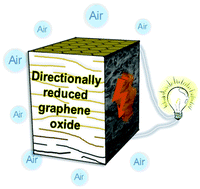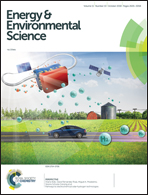Spontaneous power source in ambient air of a well-directionally reduced graphene oxide bulk†
Abstract
Spontaneous electrical potential is essential and widely exists in living cell membranes of organism, and could provide a novel power-supply system without external stimuli. However, the highly complex and delicate biological structures have restricted the huge electrical energy in practical applications. Herein, we report the spontaneous electric generation of a functional groups-reconfigured graphene oxide membrane in ambient atmosphere, which was prepared by a directionally-induced thermal reduction strategy. The as-prepared asymmetric porous graphene oxide membrane (a-GOM) with a size of only 4 mm2 can proactively generate a sustained electrical voltage of up to 450 mV in air without the need of external stimuli such as mechanical movement, light, heat, and liquid water. Of practical importance, it is easy to reach a high voltage of more than 10 V by simple series stacking of a-GOM units, powering many commercial electronic components such as liquid crystal displays (LCD) and light-emitting diodes (LED). In addition, flexible and foldable power generation devices having soft package technology (being used for the fabrication of commercial lithium-ion batteries) are achievable on the basis of the assembly of a-GOM units.



 Please wait while we load your content...
Please wait while we load your content...